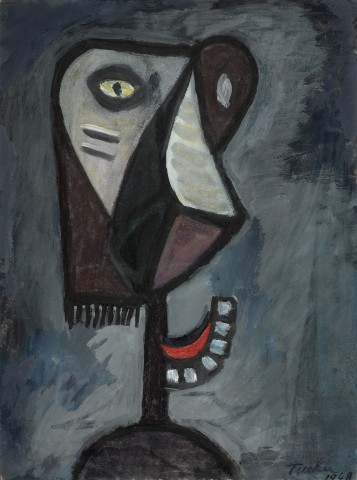SELF PORTRAIT, 1948
ALBERT TUCKER
oil pastel, synthetic polymer paint and gouache on cardboard
50.5 x 37.0 cm (sight)
signed and dated lower right: Tucker / 1948
Estate of Albert Tucker, Melbourne (label attached verso, no. 30107)
Thence by descent
Barbara Tucker, Melbourne
Sotheby’s, Sydney, 27 August 2013, lot 6
Private collection, Sydney
Albert Tucker: Works on Paper 1928–1978, Tolarno Galleries, Melbourne, 25 October – 12 November 1978, cat. 94
Albert Tucker: The Endurance: of the Human Spirit, Lauraine Diggins Fine Art, Melbourne, 1 March – 1 April 2000, cat. 10
Meeting a Dream: Albert Tucker in Paris 1948–1952, Heide Museum of Modern Art, Melbourne, 18 July – 5 November 2006
Harding, L., Meeting a Dream: Albert Tucker in Paris 1948–1952, Heide Museum of Modern Art, Melbourne, p. 53 (illus.)
In an interview with fellow artist James Gleeson in 1979, Albert Tucker reflected on the challenges of describing his own appearance in visual form, saying ‘Yes, it is very hard dealing with one’s own image… One gets trapped in a curious delusional state’.1 Despite these fears, Tucker’s self portraits speak honestly and directly of their subject at particular times in his life. The delicately painted Self-Portrait, 1937 (National Gallery of Australia), for example, depicts a young novice, serious and wide-eyed. In Self, 1983 (National Gallery of Victoria), a painting made almost fifty years later – by which time Tucker was a highly respected senior figure with a firm place in the history of twentieth century Australian art – we witness a dramatic transformation of attitude, appearance and painterly confidence. Creating self portraits throughout his career, Tucker was motivated in part by the opportunity that this subject presented for self-analysis and expression, and as well as documenting his physical appearance through the years, together, they chart the development of his artistic identity.
This 1948 self portrait was painted in Paris, a city which enchanted Tucker with its ‘wide boulevards, open skies, easy relaxed people and… the impossible gardens of Versailles’.2 Rather than presenting a recognisable image of the artist, it discards the traditions of naturalistic representation and adopts instead, a bold Cubist approach, fragmenting the human form into a series of interconnected abstract shapes. Outlined by strong painted lines, these shapes allow various perspectives of the subject to be combined into one image, facilitating the rendering of a three-dimensional subject in two dimensions. Texturally rich, the image is enlivened by a combination of painting and drawing media – oil pastel, gouache and synthetic polymer paint – and their lively, expressive application across the surface of the work. The use of simplified shapes to represent aspects of the human form was not entirely new to Tucker’s work. His renowned Images of Modern Evil series, produced during the mid-1940s, had also utilised this approach and the elegant red lips of this self portrait (echoed by the band of blocky, white teeth below), hark back to the crescent mouth – also typically coloured red – which is such a distinctive element of those now iconic images.
Like all Australian artists of his generation, Tucker had seen very little modern art and his knowledge of contemporary European painting was drawn primarily from books and magazines. But in Paris he encountered exhibition after exhibition, and this experience, he said, threw him ‘into a tailspin of awe [and] filled this screaming hunger… I’d had all my life.’3 The influence of Picasso is strong in this painting and indeed, in much of Tucker’s work from this time. Describing the Spanish master as ‘everything and more than we could have hoped … there is no one else anywhere near him’4, Tucker later observed that, ‘When one deals with a distortion, it’s impossible to avoid Picasso because of the way he… disintegrated the image, pulled it completely to pieces and kept putting it back together in different ways.’5
1. Tucker, A., interviewed by Gleeson, J., 2 May 1979, National Gallery of Australia Research Library, https://nga.gov.au/Research/Gleeson/pdf/Tucker.pdf, accessed 20 February 2023, p. 6
2. Tucker to John and Sunday Reed, Sidney Nolan and Sweeney Tucker, 14 February 1948, Barrett Reid papers, State Library of Victoria, quoted in Harding, L., Meeting a Dream: Albert Tucker in Paris 1948-1952, Heide Museum of Modern Art, Melbourne, 2006, p. 26
3. Tucker, A., interviewed by Blackman, B., 14 July 1988, quoted in Burke, J., Australian Gothic: A Life of Albert Tucker, Random House, North Sydney, 2003, p. 302
4. Tucker, 1948, op. cit., p. 31
5. Harding, L., ‘Re-picturing the Modern World 1940 – 1949’ in Harding, L. & Cramer, S., Cubism and Australian Art, The Miegunyah Press, Carlton, 2009, p. 119
KIRSTY GRANT
